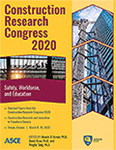Construction Research Congress 2020
Understanding the Role of Social Influence on Construction Safety Using an Ego-Centric Network Approach
Publication: Construction Research Congress 2020: Safety, Workforce, and Education
ABSTRACT
The purpose of this paper is to investigate how construction workers rely on each other on-site in terms of safety. The paper outlines how safety-oriented social networks of construction workers can be modeled to better understand the safety communication practices on site. Then, the paper presents how workers’ social networks affect their safety habits, confidence, risk perception, and overall perspective towards safety. In this regard, a social network survey is conducted, and the respondents’ social network data are collected using a personal network research design (PNRD) approach (also known as ego-centric networks) to study the connection between the individuals (ego) and their close contacts (alter). The gathered network data were used to establish their peer-to-peer relationships and quantify the influence of social network characteristics and communication patterns on their safety perspective. This social network analysis incorporated various socio-demographic factors (like experience, gender, race, degree of closeness, and network density) and the consequence of those variables on workers’ attitude towards construction safety. The findings from this study provide insights on the significance of different social dimensions and their impact on construction safety culture and performance. The results show how individual safety behavior and perception defer based on their social ties and interactions. The findings will also guide safety managers and decision-makers to improve safety culture on construction sites by offering a more holistic approach to safety management.
Get full access to this article
View all available purchase options and get full access to this chapter.
REFERENCES
Albert, A., and Hallowell, M. R. (2017). “Modeling the Role of Social Networks on Hazard Recognition and Communication.” Practice Periodical on Structural Design and Construction, 22(4), 04017016.
Albert, A., Hallowell, M. R., Skaggs, M., and Kleiner, B. (2017). “Empirical measurement and improvement of hazard recognition skill.” Safety Science, Elsevier Ltd, 93, 1–8.
Ammar, M., Zayed, T., and Moselhi, O. (2014). “Knowledge Management and Maturation Model in Construction Companies.” Journal of construction Engineering and Management, 140(4), 1–10.
Bureau of Labor Statistics US Department of Labor. (2017). “National Census of Fatal Occupational Injuries in 2017.” Bureau of Labor Statistics US Department of Labor, (202), 1–14.
Cheng, E. W. L., Li, H., Love, P. E. D., and Irani, Z. (2001). “Network communication in the construction industry.” Corporate Communications: An International Journal, 6(2), 61–70.
Gillen, M., Baltz, D., Gassel, M., Kirsch, L., and Vaccaro, D. (2002). “Perceived safety climate, job demands, and coworker support among union and nonunion injured construction workers.” Journal of safety research, 33(1), 33–51.
Halgin, S. D., and Borgatti, P. S. (2012). “An Introduction to Personal Network Analysis and Tie Churn Statistics Using E-NET.” Connections - Journal of Principal Preparation and Development, 32(1).
Holmes, N., Lingard, H., Yesilyurt, Z., and Munk, F. De. (1999). “Holmes N., Lingard H., Yesilyurt Z. and De Munk F. (1999) An exploratory study of meanings in risk control for long term and acute effect occupational health and safety risks in small business construc.pdf.” 30(4), 251–261.
HSE. (1993). “Common Topic 4: Safety Culture. Extract from: Inspectors Toolkit - Human factors in the management of major accident hazards.”
Sadri, A. M., Lee, S., and Ukkusuri, S. V. (2015). “Modeling social network influence on joint trip frequency for regular activity travel decisions.” Transportation Research Record, 2525(1), 83–93.
Wasserman, S. and K. Faust, Social network analysis: Methods and applications. Vol. 8. 1994: Cambridge university press.
Information & Authors
Information
Published In
Construction Research Congress 2020: Safety, Workforce, and Education
Pages: 481 - 489
Editors: Mounir El Asmar, Ph.D., Arizona State University, David Grau, Ph.D., Arizona State University, and Pingbo Tang, Ph.D., Arizona State University
ISBN (Online): 978-0-7844-8287-2
Copyright
© 2020 American Society of Civil Engineers.
History
Published online: Nov 9, 2020
Published in print: Nov 9, 2020
Authors
Metrics & Citations
Metrics
Citations
Download citation
If you have the appropriate software installed, you can download article citation data to the citation manager of your choice. Simply select your manager software from the list below and click Download.
